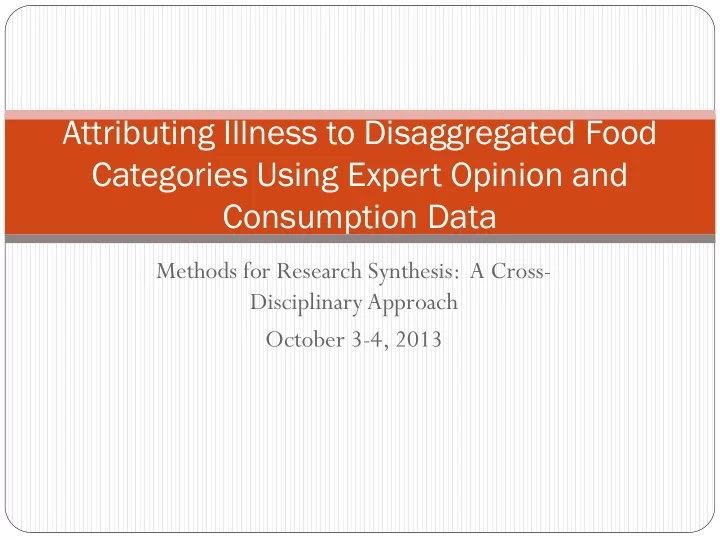

Attributing Illness to Disaggregated Food Categories Using Expert Opinion and Consumption Data Methods for Research Synthesis: A Cross- Disciplinary Approach October 3-4, 2013
Motivation Regulators make decisions about how to target scarce inspection resources Need to understand prior to consumer or food service handling the likelihood that a food Is contaminated and Will cause illness Available data is very limited Most data are from outbreak investigations Non-representative Biased toward large outbreaks, short incubation periods, and more serious illnesses 2
Task Objectives Utilize expert elicitation to: Calculate attribution rates for each disaggregated food Develop disaggregated food category and pathogen pair categories into smaller homogeneous groups with using respect to microbiological Expert opinion data contamination likelihood collected, AND Generate estimates of % of Consumption data FBI attributable to contamination that occurs before the product reaches the store shelf (excluding contamination resulting from inappropriate handling at retail and/or the home 3
Why Expert Elicitation? Lack of studies with directly relevant data Other methods of research synthesis not feasible Considerable amount of related data and knowledge Overall prevalence of foodborne illness in the United States Understanding of microbial growth under different conditions and in different food types Effectiveness of “kill steps” between manufacturer and the consumer Synthesis of inputs from multiple types of experts 4
Methods Modified Delphi technique Panel of 16 experts Experts interact through a moderator Iterative approach to eliciting opinion Mathematical aggregation of opinions Accounts for uncertainty through self-assessed confidence ratings Combine expert elicitation data with consumption data Avoids “anchoring” on outbreak-based studies 5
More on Attribution Method Even very high-risk foods may account for very few FBI if rarely eaten Percentage of FBI attributable to a specific food-pathogen pair is a function of relative likelihood of contamination AND share of consumption Relative Likelihood of Expert Opinion Contamination % of FBI Nielsen Scanner Share of Total Data Consumption 6
Questionnaire Design Supermarket concept Offers natural groupings of products Reduce cognitive burden on experts MS Excel-based self- administered questionnaire 7
Round 1 Objective: Identify food-pathogen combinations of most concern for further evaluation in the next round Questions: Pathogens that are of most concern for a given food product category Product subcategories for which the likelihood of contamination is higher than average 8
Relevant Food Categories by Pathogen from Round 1 Number of Relevant Pathogen Food Categories Astrovirus 14 Brucella Bacillus cereus 121 Brucella 3 96 Food Round 1 Start C. botulinum 110 Categories Campylobacter 45 Clostridium perfringens 67 3 Food Cryptosporidium parvum 102 Round 1 End Cyclospora cayetanensis 71 Categories Escherichia coli spp. 231 Giardia lamblia 31 Hepatitis A 138 Salmonella spp. Listeria monocytogenes 172 Norwalk-like viruses 135 96 Food Rotavirus 26 Round 1 Start Salmonella spp. 353 Categories Shigella 116 Staphylococcus 96 353 Food Round 1 End Streptococcus 14 Categories Toxoplasma gondii 14 Trichinella spiralis 4 Vibrio spp. 35 Yersinia enterocolitica 32 9
Round 2 Objective: Compare the relative likelihood of contamination for all food categories associated with each pathogen Question: Group food categories provided according to relative likelihood of contamination into following bins Negligible • Medium:High Low • High:Low Medium:Low • High:Medium Medium:Medium • High:High 10
Round 3 Objective: Estimate FBI due to contamination that happens during harvest, processing, and/or distribution stages of the farm-to-fork continuum, i.e., relevant at time of importation Question: Estimate % of FBI that might occur due to events after the product is sold, e.g., due to improper handling at retail and/or home % FBI due to Contamination that Occurs % FBI due to Contamination that Occurs Before the Product Reaches the Store = 1 - After the Product Leaves the Store Shelf Shelf 11
Attribution Rate Methodology Step 1: Map expert defined Step 4: Calculate raw food categories to Nielsen attribution rate as: scanner food categories Step 2: Normalize weighted Weighted Normalized Mean mean contamination Consumption Share Relative × in % likelihood scores such that Contamination Likelihood Score the sum of the scores across food categories for a food pathogen equals 100% Step 5: Normalize raw attribution rate such that the Step 3: Use Nielsen sales sum of the attribution rates equivalent units as proxy for for each food for a given consumption volume pathogen equals 100% 12
Considerations Other research methods are not feasible due to lack of studies Government analysts are time and budget constrained Expert elicitation is challenging and requires innovative approaches Integration of expert elicitation with other data sources Continued development of better methods to meet these challenges is needed 13
Recommend
More recommend